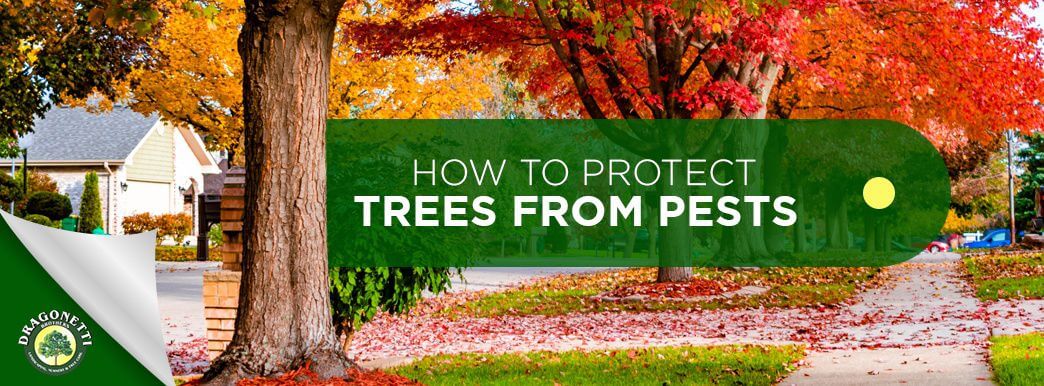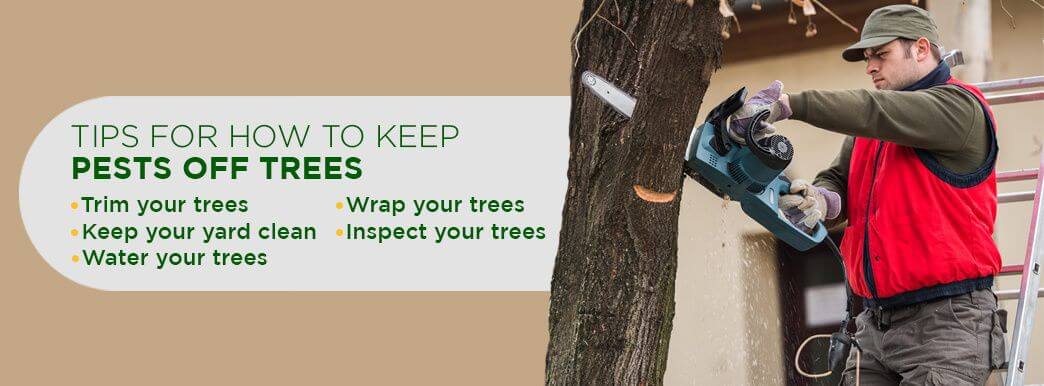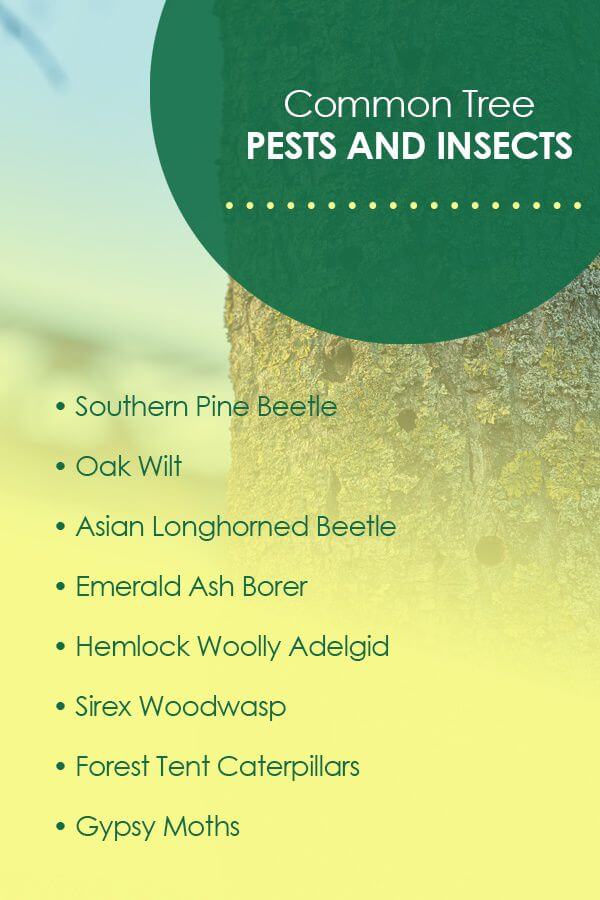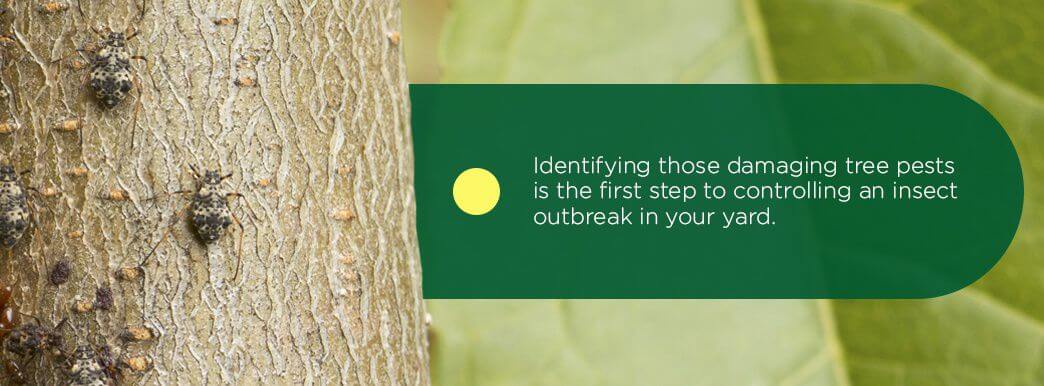
Insects can feed off the trees you have in your Manhattan, Brooklyn or Queens yard. Tree-damaging pests can spread from one tree to the other and destroy your landscaping. If left untreated, your tree could deteriorate and fall onto your house.
As a homeowner, you should know about tree pest control for your backyard. Inspect your yard at least once a month for common tree pests that could destroy your landscaping. Use this guide for more information about how to protect fruit trees and other tree species from insects.
TIPS FOR HOW TO KEEP PESTS OFF TREES

The most effective way of preventing pests and keeping them off trees is by maintaining your yard. Take care of your trees throughout the summer so they can survive the fall and winter. Here are some tips for how to care for the trees on your property.
- Trim your trees: Pruning your branches helps trees absorb more light. You can also improve the airflow in your tree by trimming the branches. Do most of your pruning in the late winter months, when dead parts of the tree could snap under the weight of heavy snow. In the summer, trim away any deteriorated branches, especially if you have spring plants. As you trim, apply rubbing alcohol to the shears to prevent the spread of tree diseases. When you finish pruning, oil the shears to avoid corrosion of the metal blades. Get rid of dried-up fruit that may be carrying a disease. In the fall, burn fallen leaves that could spread infection in your yard through their spores.
- Keep your yard clean: When you’ve finished pruning, or after a massive storm, clean your yard of any fallen branches. Beetles, aphids and other common tree pests feed on moist wood. You should reduce the clutter in your backyard before the spring when beetles are in their flight period. A clean yard free of clutter can also help you see when a pest infects the property.
- Water your trees: Consistent hydration prevents branches from drying out and breaking off. Broken, dead branches attract insects and can lead to infestations. Give yourself time to pour the water so that it can travel deep into the roots, at least three feet deep. Between watering cycles, supply your trees with an anti-desiccant spray. This product helps trees hold onto the water during dry seasons.
- Wrap your trees: Wrapping your tree in the winter prevents the wood from splitting or cracking. Pests infest exposed wood, so wrap trees that have missing pieces of bark. Beetles can crawl inside exposed wood and infect the whole tree through the inner layer of wood. You should cover your bark between November and April to keep it warm during winter. Wrap your tree in burlap, corrugated cardboard, polypropylene fabric or craft paper.
- Inspect your trees: Make sure your trees are clear of tree-damaging pests that lurk around the leaves, branches and trunk. Check your leaves for discoloration or holes. Examine the growth of your tree trunks and look for any holes or frass. You can prevent an infestation by dealing with the issue right away. If you see a branch infested with beetles or other harmful pests, remove it as soon as possible. The more you know to look for it, the less you’ll have to do in the future. Consult with your local arborist for the next steps to take when you see pests on your trees.
COMMON TREE PESTS AND INSECTS

You can prevent tree damage by identifying the pests and problems that exist in your neighborhood. In New York, you’ll have to watch out for some of these tree bugs and pests causing damage. While some of them may look harmless, they are deadly to your landscaping. Here are the eight most common tree pests and insects to look out for in your yard.
1. SOUTHERN PINE BEETLE
A Southern pine beetle (SPB) feeds on and infects pine trees. In outbreak areas, SPBs can also destroy hemlock and spruce trees. Adult beetles enter through the crevices of the outer bark of a tree, removing its nutrients. Pine trees can die within 2 – 4 months of infection.
Check your pine trees for these signs of SPB infestation:
- Small bugs 2-4mm in length.
- S-shaped tunnels below the bark
- Shotgun-patterned holes on the outside of the bark
- Popcorn-shaped clumps of resin
- Reddish-brown needles on your pine trees
2. OAK WILT
Oak wilt is a disease that infects oak trees in New York. Bretziella Fagacearum, a fungus that carries oak wilt, forms at the part of the tree that holds water. Red oak trees die within six months of infection, while white oak trees can die within a year.
Check for these signs of infection in your yard’s oak trees:
- Leaf discoloration and wilting in red and white oak trees. Red oak trees will decline more quickly than white oak trees.
- In white oak trees, brown streaks
- Defoliation in a matter of weeks
3. ASIAN LONGHORNED BEETLE
The Asian longhorned beetle (ALB) has infected VARIOUS AREAS THROUGHOUT NEW YORK. Adult ALBs lay eggs inside the bark. Their larvae bore galleries to feed, disrupting the vascular flow of the tree.
Check for these signs of ALB infestation in your maple, birch, willow or sycamore trees:
- Round, deep half-inch holes that emerge throughout the tree in late July
- The outer layer of the bark shows half-inch depressions
- Sap oozing from holes and depressions
4. EMERALD ASH BORER
The emerald ash borer (EAB) attacks all ash trees native to New York. They typically only fly within HALF A MILE of their emergence site. EAB can travel through ash firewood or nursery stock.
Signs of EAB larvae infection in trees include:
- Yellowing, dieback and browning of leaves
- Increase in woodpecker activity
- Large strips of bark falling off
- S-shaped feeding galleries containing sawdust and frass
- D-shaped holes in the spring as adults emerge
5. HEMLOCK WOOLLY ADELGID
The hemlock woolly adelgid attacks Carolina and Eastern hemlock trees. Young crawlers feed on the tree’s stored starches. This lifelong feeding takes away some vital nutrients from the tree. As a result, trees die within 4 – 10 years.
Things to look for with this insect infestation include:
- They measure a tiny 1.5mm in length.
- White, woolly masses underneath the branches of the tree
- Gray-tinted tree needles
- Lost needles and dead branches
6. SIREX WOODWASP
The Sirex woodwasp, native to Eurasia, has no known natural native controls. Female woodwasps inject toxic mucus when they’re laying eggs into the bark of pine trees. The mucus kills the trees from the bottom up. Fungus feeds on the dead trees, and wood wasp larvae feed on the fungus. Since they bore themselves deep into the wood’s layers, Sirex woodwasps are hard to spot. You would know you have a Sirex woodwasp infestation if your tree rots.
7. FOREST TENT CATERPILLARS
Forest tent caterpillars (FTCs) eat the leaves of hardwood trees in the spring. This defoliation can kill certain types of trees. Deciduous trees can withstand defoliation for up to 3 years. The stress they undergo from their lack of strength is what kills them.
FTCs destroy shade trees and ornamental plants in urban and suburban areas. Here are some signs that your trees suffer from a tent caterpillar infestation:
- You see bugs with white, footprint-shaped marks on their backs.
- You see bugs with light blue stripes on their sides.
- Dark, cylindrical egg masses that could contain up to 350 eggs
8. GYPSY MOTHS
Gypsy moths are notorious for destroying hardwood trees in New York. As their egg masses emerge in the spring, larvae defoliate the trees around them.
Here are signs that you have a gypsy moth outbreak in your tree population in the spring:
- Yellow, teardrop-shaped egg masses that could contain 600 to 700 larvae
- You find caterpillars that measure 2 1/5 inches in length
- You find caterpillars with blue and red spots on their backs
- White moths with brown markings
HOW TO CONTROL TREE INSECTS

Identifying those damaging tree pests is the first step to controlling an insect outbreak in your yard. The way you handle the insect population in your yard depends on the type of pest you may have. Here are some tips for dealing with every kind of common tree pest in New York.
- Southern pine beetles: If your tree has an outbreak of Southern pine beetles, the best option may be to remove the tree from your property. Insects from an infected tree could spread to other trees in your yard. You should cut down the tree at the first sign of infestation to prevent the spread of beetles when the eggs hatch. You could try to get rid of SPBs with specific insecticides, but they’re usually ineffective. Insecticide works better on young trees.
- Oak wilt: Like with SPBs, deal with the fungus that causes oak wilt disease by getting rid of existing sites to prevent the spread to new locations. Experts are working on a chemical treatment to cure oak wilt in trees. Oak wilt could spread through the spores of trees. Cut down a tree and wrap it in plastic to prevent the spores from infecting other nearby trees.
- Asian longhorned beetle: Destroying the infested tree is the only way to prevent the spread of ALBs to other trees. Consult a local arborist about how to remove the infected tree from your property.
- Emerald ash borers: Insecticide has proven effective for killing EABs. You can get rid of EABs by drenching the soil around your tree with insecticide. The insecticide travels through the roots of a tree into the trunk and branches. EABs die from ingesting the tissue that is now poisonous to them. You could also apply insecticide through injection or spraying. Like other insects, you can remove the dead areas of your tree to stop the spread of infection.
- Hemlock woolly adelgid: Systemic Insecticide can get rid of HWA. You could drench the moist soil around your tree with a solution of insecticide and water, or use a soil injector to infuse insecticide into the ground. You could also inject a tube filled with insect poison into the trunk.
- Sirex woodwasps: You could use a species of parasitic nematode to kill Sirex woodwasps. Deladenus Siricidicola can infect the larvae and sterilize females. As a result, females lay eggs filled with nematodes that feed on the woodwasp population.
- Tent caterpillars: You can usually remove caterpillar larvae and eggs by picking them up by hand and tossing them into soapy water. Get rid of tent caterpillars in the early morning or evening while they’re in the nest. You could also use selective insecticide that targets tent caterpillars.
- Gypsy moths: Prevent gypsy moths by keeping your yard clean, so they don’t have a place to lay eggs. Targeted insecticides can kill them, especially when they’re young. You can also use natural pesticides, but only after targeted insecticide doesn’t work.
WHEN AND HOW TO TREAT TREES WITH PESTS
You should try to control pests and tree insects in the fall to protect your tree in the spring. Here are some ways to control the insects that kill trees.
- Attract bugs that are predators of tree insects: Some insects are beneficial for your tree because they feed on these harmful pests. Ladybugs eat aphids and other types of borers. Spiders, lacewings and dragonflies are predators of some tree pests. To attract these helpful insects, plant a variety of local plants in your garden. Mulch can hide spiders as they stalk their prey.
- Preserve the life of your tree: Tree-harming pests often feed on trees that are already damaged. Check the pH of your soil to make sure it’s healthy for the species of your tree. Water your tree at least once a week throughout the year. Nourish the roots with fertilizer and prune away dead branches.
- Natural pesticides: Try not to spray your trees with insecticides. If you use pesticides with chemicals, you could harm the safe bugs as well as the dangerous ones. Pesticides with natural oils can suffocate small harmful insects. Saturate the tree branches and bark with oil-based safe insecticides for trees.
- Systemic insecticide: Some pesticides can protect your trees from insects throughout the year. Apply the insecticide, available in dry granule or liquid form, to the bottom of the tree. The roots carry the poison through to the leaves and branches. When should you spray trees with systemic insecticide? It’s best to wait until your tree is actively growing.
- Remove infected trees: To preserve the beauty of a yard with several trees, you should remove a heavily infected tree, so you don’t contaminate the others. To remove a tree from your yard, you need to call a professional arborist. Contact your local tree removal company to protect your backyard from tree pests.
CONTACT DRAGONETTI BROTHERS TREE REMOVAL FOR A FREE QUOTE
If you live in Brooklyn, Queens, Manhattan or the surrounding New York area, call Dragonetti Tree Removal to remove the infected trees from your property. As a family-owned business, we care about you as our customer. We can handle any size job, from pruning to tree removal. To deal with a tree pest outbreak, request a free quote online or call (718) 451-1300 for your pest management needs.
